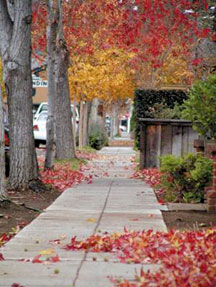Tree Roots and Sidewalks – Alternatives to Root Pruning
The below information was writen by the Rochester Forestry Division. For additional information call 507-328-2515 or email Jacob Ryg, the Rochester City Forester.
Root Barriers
Three Types
- Deflectors– redirect root growth
- Inhibitors– contain chemical compounds which prevent root development
- Traps– root penetrates through fiber and is not allowed to grow radially
Top edge must be at least 1 inch above soil level to prevent roots from growing over top edge.
If plastic barriers are used they should be:
- High density polyethylene
- UV resistant– prevents deterioration of above ground portion
- Thermal durability– doesn’t get brittle during colder months of the year
- Connections should not be easily twisted or pulled apart
*Effectiveness is species dependent
Gravel Sub Base
- Layer must consist of 3/4 inch gravel pieces or larger
- Must be 6 inches thick or thicker
- Have no fill or fines between gravel, just air space
- Air space prevents root growth due to the lack of moisture gravel can hold forcing roots to grow deeper under sidewalk
Rebar in Concrete
- Reinforces concrete to resist cracking
- Holds cracks tightly together if cracking does occur
- Extra weight makes it harder for roots to lift sidewalk slabs
Reroute sidewalk
- Little to no root pruning required
- Adds unique aesthetics to neighborhoods
- Landowner must grant pedestrian easement for sidewalk
- Landowner must straighten out sidewalk again after tree removal
Sidewalks settle, raise, and crack due to soil characteristics, soil freezing and thawing cycles (heaving), inappropriate installation, tree roots, and age. Most sidewalks are built to last only 25 years with or without the influence of trees on this hardscape.
As they deteriorate, they become a trip hazard for pedestrians. If this deterioration is caused by tree roots, it often looks like the below image. The roots grow here because there is an abundance of moisture and oxygen. Due to the compaction needed for sidewalk construction, the roots grow as close to the surface as they can for oxygen. Moisture is also abundant here due to runoff from the surface.
Root pruning subjects tree roots to decay or simply removes a large portion of the tree’s critical structural roots. When root pruning is done a tree can experience canopy dieback or worse, failure.
For more information see:
- Pruning Shade Trees in Landscapes
- L.R.Costello and K.S. Jones. Reducing Infrastructure Damage by Tree Roots: A Compendium of Strategies. 2003.
A PDF of the flyer with the above information can be downloaded here.





